Polenta. Chou frisé {kale}. Œuf poché. Bonheur.
par Darya
Il est depuis peu possible de trouver du chou frisé non pommé à Lille. J’en ai déjà parlé une fois. Depuis quelques semaines, mon fournisseur bi-mensuel de légumes locaux propose ce chou, et comme je le trouve plutôt bon et intéressant à cuisiner, j’en commande à chaque fois que je peux. Ce qui me semble intéressant avec ce chou est qu’il peut avoir une utilisation différente de celle de ses cousins le chou de Milan, le chou blanc et le chou rouge, et que son goût est plus subtil. Aujourd’hui, je vous propose de le poêler. Il y a quelques semaines, j’ai poêlé mon chou avec toutes sortes d’autres légumes, et les ai servis avec du riz complet et de la sauce soja. C’était excellent. Ce que j’aime quand on poêle le chou frisé, c’est qu’il conserve bien sa forme, sans s’affaisser comme le feraient les blettes ou les épinards. Aujourd’hui, je l’ai poêlé un peu autrement, et ce fut un véritable coup de cœur. Je referai cette recette à l’occasion. Je suis partie d’une recette provenant du Sud des États-Unis, les grits. Il s’agit d’une préparation très simple (et délicieuse) à base de maïs blanc (hominy) moulu, cuit à l’eau puis agrémenté de beurre et de fromage râpé. Les grits étant impossibles à trouver par chez moi, j’ai utilisé de la polenta instantanée à leur place, et cela fonctionne à merveille. Un peu de beurre, un peu de cheddar fermier râpé, le tout servi sur un lit de chou poêlé, et agrémenté d’un œuf poché. C’est simple, rapide, et absolument délicieux. Le seul désavantage de cette recette est la proportion de vaisselle par rapport au peu d’efforts qu’elle demande. Mais la recette en vaut largement la peine.
Ingrédients (pour 1 personne)
– 100 à 150 gr. de chou frisé non pommé (curly kale), environ 5-6 branches moyennes
– 1/2 oignon moyen, finement émincé
– 1/2 gousse d’ail écrasée
– 1 c. à soupe d’huile d’olive
– Sel
– 50 gr. de polenta instantanée- 150 à 170 ml d’eau
– Sel
– Une noisette de beurre doux
– Du cheddar râpé (environ 2 c. à soupe)
– 1 œuf
– Une pincée de sel et 1 c. à soupe de vinaigre (de vin) blanc
– Du poivre noir et/ou du piment d’Espelette en poudre
Recette
– Laver le chou ; il est inutile de l’essorer. Ôter les côtes et hacher/déchirer les feuilles en petits morceaux. Faire chauffer l’huile d’olive dans une poêle. Ajouter l’oignon et faire revenir à feu moyen-doux jusqu’à ce qu’il soit translucide (environ 5 minutes). Ajouter l’ail. Après 30 secondes, ajouter le chou frisé et une ou deux cuillers à soupe d’eau. Couvrir et laisser cuire une dizaine de minutes à feu doux en mélangeant une ou deux fois.
– Pendant ce temps, porter deux petites casseroles d’eau à ébullition, dont une avec les 150-170 ml d’eau pour la polenta (elle devrait bouillir avant l’autre, puisqu’elle contient moins d’eau). Dans l’eau pour la polenta, ajouter une grosse pincée de sel puis baisser le feu et verser la polenta en pluie tout en mélangeant constamment à la cuiller en bois. La polenta est prête lorsqu’elle se détache des parois de la casserole (environ 1 à 2 minutes). Ôter du feu, ajouter une noisette de beurre, les 3/4 du cheddar râpé et environ 1/3 du chou cuit. Mélanger et couvrir jusqu’au moment de servir.
– Lorsque la polenta est prête, préparer l’œuf poché. Casser l’œuf dans un ramequin en veillant à conserver le jaune intact. Ajouter à l’eau bouillante (de la deuxième casserole) une pincée de sel et 1 cuiller à soupe de vinaigre. Touiller pour créer un tourbillon, baisser le feu à frémissements et verser l’œuf dans le tourbillon en n’hésitant pas à immerger légèrement le ramequin pour que l’œuf ne tombe pas de haut. Baisser le feu au minimum, couvrir la casserole et cuire environ 3 minutes, jusqu’à ce que le blanc soit légèrement ferme mais le jaune encore coulant. Retirer l’œuf à l’aide d’une écumoire et le sécher délicatement sur du papier absorbant.
– Durant les trois minutes de cuisson de l’œuf, dresser l’assiette. Verser le chou frisé cuit en prenant soin d’ôter la gousse d’ail écrasée. Verser la polenta sur le chou. Parsemer du reste de cheddar. Ajouter enfin l’œuf égoutté. Poivrer et/ou parsemer de piment d’Espelette.
Bon appétit !
The English-speaking corner
Wilted kale, cheesy polenta, and poached egg = happiness
I have mentioned in a previous post that it has recently become possible to find kale in Lille. Well, at least one variety can be found: curly kale, but I do not lose hope of seeing other kinds in the future. What is new is that my local « CSA » has started carrying it, so every now and then, I order a bunch or two from there, as I like the taste and find it interesting to cook with it. What I find interesting is that it can have different uses than those of its cousins, Savoy cabbage, white cabbage, and red cabbage. Also, its taste is more subtle. Today, I wilted this kale in a frying pan. A few weeks ago, I tried stir-frying my kale with lots of other vegetables, and served it with brown rice and soy sauce; it was excellent. What I like with kale is that it doesn’t collapse completely like spinach or chard. Today, I did something different, and liked it so much I will definitely be doing this again in the future. It all started with a recipe I cannot make here in France: grits. Grits are just nowhere to be found. I just pretended that polenta and grits were one and the same thing, and the recipe turned out delicious. I added a little butter and grated (farmhouse) cheddar to my cooked polenta, and served it atop a bed of wilted kale. I added a poached egg on top of the grits. I sprinkled the egg with Espelette pepper. It was heavenly. Simple, quick(-ish), and truly delicious. The only negative side to this recipe is the amount of washing I ended up with, especially when the recipe itself requires hardly any work. But that will not stop me from making this dish again.
Ingredients (serves one)
– 100-150 gr. (about 4-5 oz) curly kale (about 5-6 sprigs, does one say sprigs when speaking of kale?)
– 1/2 a medium onion, finely minced
– 1/2 a garlic clove, smashed
– 1 Tbsp olive oil
– Salt
– 50 gr (1.7 oz) instant polenta
– 150-170 ml water (a bit less than 3/4 cup: the volume of water should be 3 times the volume of the polenta)
– Salt
– 1 small knob of butter
– About 2 Tbsp grated cheddar
– 1 egg
– A pinch of salt and 1 Tbsp white (wine) vinegar
– Freshly ground black pepper and/or red pepper flakes (I used ground Espelette pepper)
Recipe
– Wash the kale; no need to dry it. Remove the stems and chop or tear the leaves into small pieces. Heat the olive oil in a pan over medium-low heat. Add the onion, and cook, stirring, until translucent (about 5 minutes). Add the smashed garlic. After about 30 seconds, add the kale and 1 or 2 tablespoons of water. Cover and cook over low heat for about 8-10 minutes, stirring occasionally.
– While the kale is cooking, bring two small pots to a boil; one of the two pots should contain the water for the polenta. Add a pinch of salt to the polenta water, lower the heat, and add the polenta in a thin stream, stirring constantly with a wooden spoon. The polenta is ready when it no longer sticks to the sides of the pan. Remove from the heat, and add the butter, most of the cheddar, and about a third of the cooked kale. Fold in, and cover until ready to serve.
– When the polenta is ready, poach the egg. Break the egg in a small ramequin, making sure to keep the yolk intact. Add a pinch of salt and a tablespoon of vinegar to the second pot of boiling water. Stir to create a vortex and lower to heat to a very light simmer. Delicately pour the egg into the middle of the vortex; it is alright if the ramequin touches the water, as the egg shouldn’t fall into the water from too high. Lower the heat to the minimum, cover the pot, and cook for about 3 minutes. The white should be set, but the yolk still runny. Remove the egg using a slotted spoon and pat the egg delicately with a paper towel to dry it.
– During the 3 minutes it takes to cook the egg, prepare your plate. Put all the cooked kale on the bottom, and top with the polenta. Add the remaining cheddar cheese. Top with the egg, and sprinkle with black pepper and/or Espelette pepper. Enjoy.
Bon appétit!
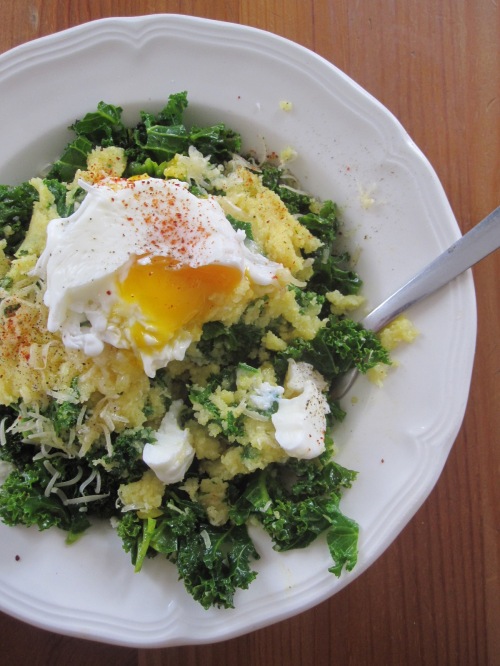
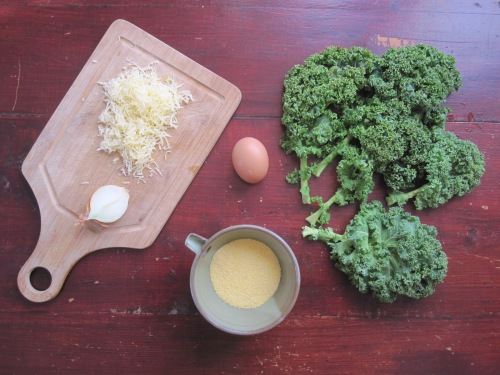
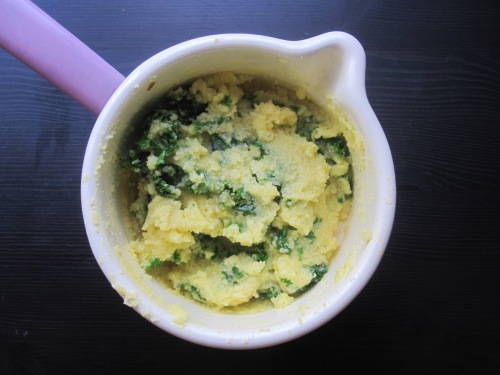
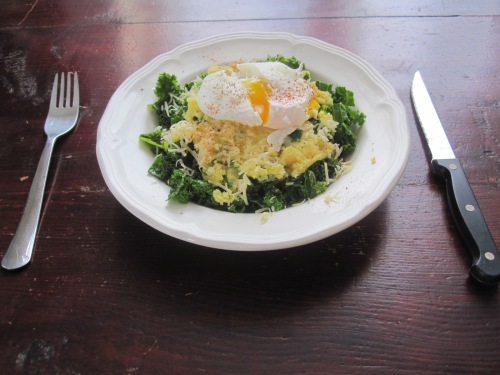
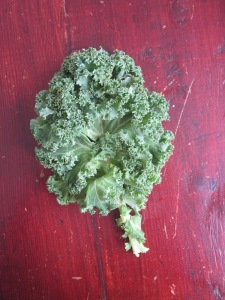

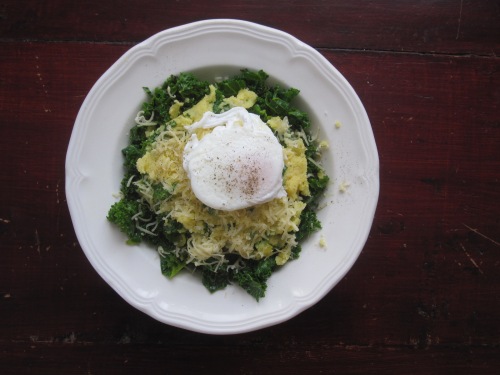

Wonderful combination!
Thank you!
Darya, this looks gorgeously amazing. I’m bookmarking this. I saw your video. Very professional! Brava!!!
I am glad you like this recipe, let me know if you make it some day. And thank you for watching the video, it was quite an experience!
I love that it doesn’t get all mushy when cooked as well. Have your tried growing it? So easy to do.
I wish I could grow it. I live in a city, and don’t even have a balcony, so unless I can grow it in a small pot on the windowsill… I’ll just have to continue buying my kale from the store/farm. 🙂
You might be able to grow it in a pot. They don’t need much space.
Ça donne faim!
J’aime beaucoup les recettes à base de chou ,le chou kale il va falloir que je goûte ! bonne soirée
Si tu as l’occasion, je te le conseille ! Son goût est assez doux mais c’est surtout pour sa texture qu’il est intéressant.
I like polenta but rarely eat it. This healthy ensemble of ingredients, with a beautiful egg on the top is so inviting.
Thank you, Fae. I also very rarely eat polenta. When I do, I always wonder why. This is a great way!
Coucou 🙂 ah la vaisselle !^^’ Je compatis ! Je frôle l’overdose …
Merci pour cette jolie recette saine et gourmande ! 🙂
Bonne soirée 🙂
Plein de bisous ❤
Haha, oui, la vaisselle, un vrai calvaire ! Mais ça vaut le coup, la recette est délicieuse. Bises et bonne semaine 🙂
Nice post! I love the addition of polenta/grits. This is so up my alley. I eat a similar meal most nights when I don’t have the time to cook. I have yet to add cheese, it seems just the thing to elevate it from good to great! And the poached egg looks perfect here. I love that. Yum! I’m so glad you’re using more kale!
Thanks, Amanda. I am enjoying experimenting with kale (I’ve still got a large bunch at home); I’ve even tried making green smoothies with it, and liked them. The cheddar really adds a pleasant saltiness to the dish (you could use crumbled bacon too, it would be delicious).
Simply delicious!
Je rouve que ton chou frise a beaucoup d’allure. Je travaille plus souvent avec le chou de Savoie, mais le Kale a l’air tres interessant, je vais certainement l’utiliser. Bon Lundi.
J’adore aussi le chou de Savoie, mais sa texture est assez différente de celle du Kale; je l’utilise surtout pour faire des petits farcis ou des soupes. Si tu trouves du kale, je te conseille d’essayer, c’est délicieux et plus doux au goût, on peut même le manger cru. Bonne semaine Linda !
bon le kale je connais, la polenta aussi (pas la variante américaine) mais ensemble avec un oeuf ça me plait encore plus. très bon
Merci Marie ! L’œuf sur le dessus c’est vraiment la cerise sur le gâteau.
Je ne vais sans doute pas t’étonner si je te dis que je ne connais pas ce chou ? d’après ce que tu en dis c’est très bon, ce qui ne m’étonne pas car j’aime tous les choux ! il me régale toujours quelque soit la recette ! Je regrette vraiment de ne pas pouvoir goûter la tienne avec cet oeufqui coule comme ça sur le dessus ! hummm !! j’adore ! Gros bisous
Tu sais, ce chou n’est pas encore très facile à trouver en-dehors de Paris, donc je ne suis pas surprise que tu ne le connaisses pas encore. Moi-même, je le découvre depuis peu. Mais si tu aimes le chou, il est certain que tu aimeras celui-ci ! Bises
Brilliant….deliciously clever idea 🙂
Thank you!
je n’ai toujours pas essayé le chou kale mais grace à toi, j’ai déjà plusieurs idées pour la fois où je me lancerai.
Si tu aimes le chou, il n’y a pas de raisons que tu n’aimes pas le kale (de là à en être obsédé comme certains, il ne faut pas exagérer, à moins que la quantité de vitamine C contenue dedans t’importe plus que son goût). J’ai encore d’autres idées, je suis encore dans la phrase d’apprivoisement.
This looks delicious! I love all the colours- definitely a recipe to try!
So funny how long it has taken kale to get to France. And perhaps we should start « The Grits Project, » like was done with kale. I’m definitely missing France + I live in grits country. So, clearly, I am just the person to start that. 🙂 Lovely dish. I often make something similar.
It must have existed before; I’ve even seen it in public gardens, as a decorative plant! It is widely used in all the neighboring countries, so I cannot imagine why it is such a rarity in France. But it is getting more easily available 🙂 I love your idea of starting a Grits-campain, but you would have to convince the French that corn isn’t the tasteless, boring thing you buy in cheap cans and use to give color to mayo-smothered salads they think it is!
I have always been amused by the canned and frozen corn in mediocre French salads. Where do you figure that began?!
I don’t know how canned corn ever made it to France, but that is definitely the reason for my hating corn until fairly recently. 🙂
I love this recipe Darya. So original using kale with polenta (grits) and and a beautifully placed egg. I think adding the farmhouse cheddar and butter to your grits was brilliant. I enjoyed reading your method on cooking the egg. I make poached eggs often but I’ve never created a vortex before sliding the egg into the water! Nice. I’ll do that next time.
Thank you! I find that creating a vortex in the water helps keep the egg white around the yolk; it took me some practise, but I almost always get it right nowadays.
That makes perfect sense Darya. I can’t wait to try it. We eat poached eggs every weekend.
j’adore cette recette à faire très vite ! merci
There is always this amazing fresh look to everything you cook. I am not sure how to describe it, but your dishes are always so vibrant! Beautiful
Thank you!
Un pur bonheur Darya, tu as bien raison !
Coucou ! J’ai taggé ton blog dans le cadre des Liebster Award qui visent à promouvoir de nouveaux blogs. Si tu veux y participer, toutes les informations sont sur : http://marionsbakery.wordpress.com/2014/03/17/liebster-award/
Je te remercie Marion, ça me fait très plaisir ! Je vais aller découvrir ton blog et les autres nominations de ce pas.
J’adore ce genre de plat… En tout cas, malgre l’influence anglaise, je pense que j’opterai pour du parmesan plutot que du cheddar… 😀
Oh my goodness, this looks so good, Darya! I love kale (couldn’t find any non-curly over here either), polenta and poached eggs, but never had them in one plate.I guess I should, thanks for the inspiration!
There’s a definite zing of happiness for me, when I see the runny egg and creamy polenta too! What a combination. We’re nearing cooler days now as Sydney shifts to autumn and I’ll need food like this to keep me going soon.
Quel dommage que ce chou ne soit pas très apprécié chez moi alors que j’en trouve à chaque coin de rue … Par contre, l’idée de la polenta me tente terriblement, tu t’en doutes bien ! Il faudrait que je tente avec un autre légume, je suis certaine que cela plairait !
Merci pour ces belles idées gourmandes, Darya! 😉
Bisous, et belle semaine !
Ah oui, c’est bien dommage ! Mais avec des épinards, des blettes ou n’importe quelles fanes ça devrait être bon aussi (même si la texture sera différente).
Merci pour ton gentil commentaire Lyne. Bises
je n’ai tjs pas gouté ce fameux chou, peut on le remplacer par un autre (je crois ne l’avoir jamais vu sur les étals de mon marché) ?
Dans cette recette, j’utiliserais des blettes ou des épinards à la place du kale. Les feuilles tomberont plus vite, la texture sera différente et ce sera cuit plus rapidement, mais ce sera certainement délicieux quand même. C’est la première année qu’on trouve du kale à Lille, et encore, il faut savoir où en chercher (je le commande à la Ruche qui dit oui, car au marché il n’y en a pas).
Je cherche désespérément du Kale sur Lille pour me rappeler NYC!
Vous pourriez me donner le tuyau?
Merci 🙂
Bonjour Seb,
Malheureusement, je crains que la saison du kale ne soit terminée pour cette année, cela fait en tout cas des semaines que je n’en vois plus.
J’en ai trouvé d’octobre à fin mars sans aucune difficulté dans les boutiques bio et à la Ruche qui dit oui. Je pense qu’il va simplement falloir patienter.
Super, on va attendre alors 🙂
Je viens de déguster cette recette et j’ai adoré. Je regrette juste l’utilisation de la polenta instantanée (même si c’est pratique lorsqu’on ne veut pas perdre des heures à cuisiner). Je pense la refaire, mais cette fois avec de la polenta gros grain et des épinards.
Merci en tout cas pour cette découverte (j’ai même sauvé un petit escargot qui se cachait dans mon chou kale)
Génial ! Je suis ravie que ça t’ait plu, merci pour ton retour. Avec de la polenta traditionnelle, le résultat sera plus crémeux et moins sec, mais comme tu dis, ça prend aussi bien plus de temps (même si je ne qualifierais pas ça de « perte » de temps 🙂 )
Hum ça a l’air délicieux !